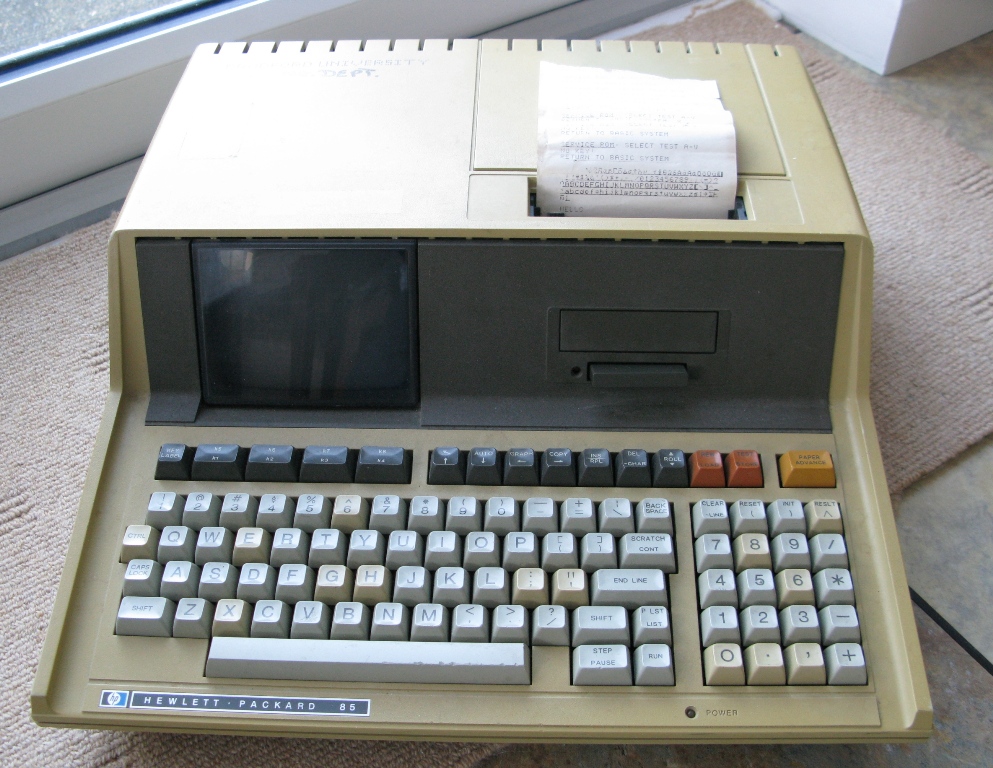1980s Vintage Computers
Hewlett-Packard Series 80 - HP-85

The HP-85 was the first of the 'Series 80'. It is currently my favourite machine, due to a number of features:
- Built in screen, tape drive and printer.
- High quality text and graphics.
- Superb build quality and keyboard.
- Range of plug-in interfaces eg HP-IB, Serial.
- Powerful 32K BASIC in ROM.
- Range of additional 8K ROMs or EPROMs (paged in).
- Can plug-in wide range of peripherals (via matching interface module)
A key feature is that the interface modules and memory can be connected without removing the case, something that was not common on contemporary PCs, and is now a common feature through USB. nb Always disconnect the power when changing modules.
There are some downsides compared to other 1980s machines, such as:
- Custom processor hence very little commercial software available.
- Proprietary design with no 3rd party hardware.
- It is really a hugely extended programmable calculator rather than a general purpose computer.
- No provision for external (ie larger!) display.
- Old tapes tend to have lost their data faster than old floppies.
My current set up is a HP-85A with 6 ROMs (Input / Output, Mass Storage, Advanced Programming, Printer / Plotter, Matrix and Assembler), 16K RAM added (making 32K total), HP-IB interface and Serial interface.
On the HP-IB port I have an HP 82901M dual 5¼" floppy drive, which is much faster than the built in tape. I recently found a HP 9121C dual 3.5" floppy drive, so can copy disks between the two formats and to tape. I have a serial HP plotter but this is not yet connected.
I also have the later HP-85B, this has built-in I/O, Mass Storage and EDISK ROMs, the latter includes GET/SAVE commands to load text files as BASIC or Assembler programs. It has 32K of user RAM, plus 32K of memory only accessible through the EDISK ROM, which is a virtual disk (expandable to 140K with one 128K RAM module).
HP also released an HP-83, which lacked the built-in tape drive and printer. For further information on these and the industrial version, the HP-9915 please see the Series 80 links. Later HP released the HP-86 and HP-87, based on the same processor but with a larger memory address range, extended BASIC and better displays.
I have a 'Programmable ROM Module' and can use this to run code from a 2764 EPROM, so far I have copied some of the ROMs to EPROM such as the Assembler and Extended Mass Storage. Bill Kotaska has made a copy of this module, to allow any HP series 80 owner access to the available ROMs, especially the more hard-to-find ones like the Assembler. This is now available as the PRM-85 module.
I bought a 'Speech Synthesis Module' which came with the software on disk and a manual. The disk contains pre-recorded words and phases such as 'power', 'on', 'time' etc, here is a short recording! Recently I bought a Modem Module, but this is very limited these days as it only goes up to 300 baud (56K was a long way off) and I don't know of any bulletin boards in the UK that it would work with.
I have several of the HP manuals, and am very impressed by the quality of the information contained. Here is an example page from the HP 85 Owners Manual and Programming guide. This manual together with nearly all of others can be downloaded from the HP Series 80 site - many thanks vp! There are also some excellent service manuals available, useful for fixing faults such as power supply problems.
Thanks must also go to vp for finding much of the existing software and hosting it on the HP Series 80 site. There are a few packages I would still like to find so if you have any other software or program listings, please e-mail me.
There are a few modern add-ons for the Series 80, see Links.
This page was last revised on: 12/04/09